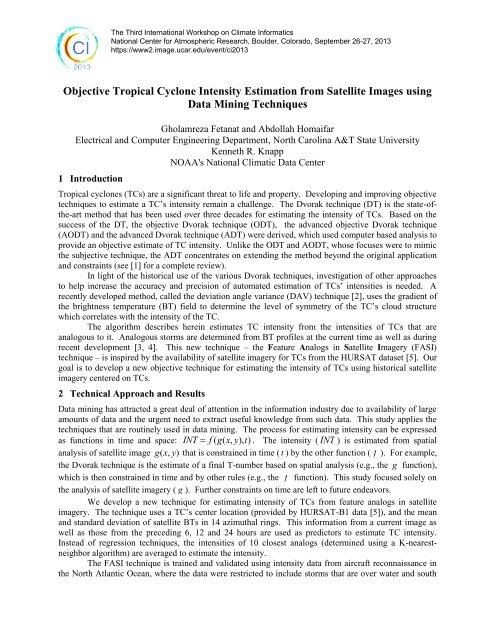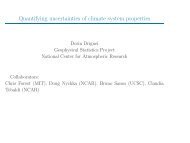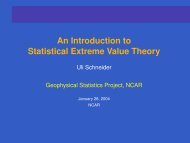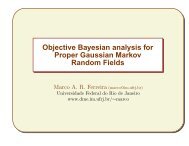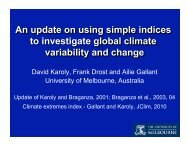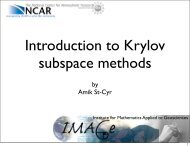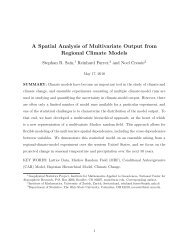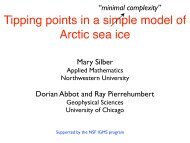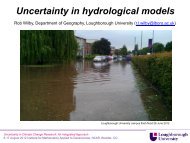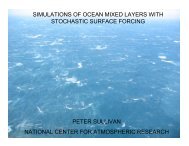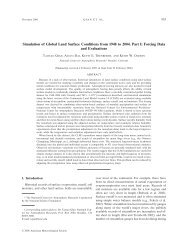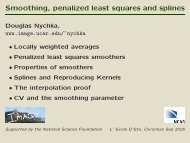Objective Tropical Cyclone Intensity Estimation from Satellite Images ...
Objective Tropical Cyclone Intensity Estimation from Satellite Images ...
Objective Tropical Cyclone Intensity Estimation from Satellite Images ...
Create successful ePaper yourself
Turn your PDF publications into a flip-book with our unique Google optimized e-Paper software.
The Third International Workshop on Climate Informatics<br />
National Center for Atmospheric Research, Boulder, Colorado, September 26-27, 2013<br />
https://www2.image.ucar.edu/event/ci2013<br />
<strong>Objective</strong> <strong>Tropical</strong> <strong>Cyclone</strong> <strong>Intensity</strong> <strong>Estimation</strong> <strong>from</strong> <strong>Satellite</strong> <strong>Images</strong> using<br />
Data Mining Techniques<br />
Gholamreza Fetanat and Abdollah Homaifar<br />
Electrical and Computer Engineering Department, North Carolina A&T State University<br />
Kenneth R. Knapp<br />
NOAA's National Climatic Data Center<br />
1 Introduction<br />
<strong>Tropical</strong> cyclones (TCs) are a significant threat to life and property. Developing and improving objective<br />
techniques to estimate a TC’s intensity remain a challenge. The Dvorak technique (DT) is the state-ofthe-art<br />
method that has been used over three decades for estimating the intensity of TCs. Based on the<br />
success of the DT, the objective Dvorak technique (ODT), the advanced objective Dvorak technique<br />
(AODT) and the advanced Dvorak technique (ADT) were derived, which used computer based analysis to<br />
provide an objective estimate of TC intensity. Unlike the ODT and AODT, whose focuses were to mimic<br />
the subjective technique, the ADT concentrates on extending the method beyond the original application<br />
and constraints (see [1] for a complete review).<br />
In light of the historical use of the various Dvorak techniques, investigation of other approaches<br />
to help increase the accuracy and precision of automated estimation of TCs’ intensities is needed. A<br />
recently developed method, called the deviation angle variance (DAV) technique [2], uses the gradient of<br />
the brightness temperature (BT) field to determine the level of symmetry of the TC’s cloud structure<br />
which correlates with the intensity of the TC.<br />
The algorithm describes herein estimates TC intensity <strong>from</strong> the intensities of TCs that are<br />
analogous to it. Analogous storms are determined <strong>from</strong> BT profiles at the current time as well as during<br />
recent development [3, 4]. This new technique – the Feature Analogs in <strong>Satellite</strong> Imagery (FASI)<br />
technique – is inspired by the availability of satellite imagery for TCs <strong>from</strong> the HURSAT dataset [5]. Our<br />
goal is to develop a new objective technique for estimating the intensity of TCs using historical satellite<br />
imagery centered on TCs.<br />
2 Technical Approach and Results<br />
Data mining has attracted a great deal of attention in the information industry due to availability of large<br />
amounts of data and the urgent need to extract useful knowledge <strong>from</strong> such data. This study applies the<br />
techniques that are routinely used in data mining. The process for estimating intensity can be expressed<br />
as functions in time and space:<br />
. The intensity ( ) is estimated <strong>from</strong> spatial<br />
analysis of satellite image g ( x,<br />
y)<br />
that is constrained in time ( t ) by the other function ( ). For example,<br />
the Dvorak technique is the estimate of a final T-number based on spatial analysis (e.g., the g function),<br />
which is then constrained in time and by other rules (e.g., the f function). This study focused solely on<br />
the analysis of satellite imagery ( g ). Further constraints on time are left to future endeavors.<br />
We develop a new technique for estimating intensity of TCs <strong>from</strong> feature analogs in satellite<br />
imagery. The technique uses a TC’s center location (provided by HURSAT-B1 data [5]), and the mean<br />
and standard deviation of satellite BTs in 14 azimuthal rings. This information <strong>from</strong> a current image as<br />
well as those <strong>from</strong> the preceding 6, 12 and 24 hours are used as predictors to estimate TC intensity.<br />
Instead of regression techniques, the intensities of 10 closest analogs (determined using a K-nearestneighbor<br />
algorithm) are averaged to estimate the intensity.<br />
The FASI technique is trained and validated using intensity data <strong>from</strong> aircraft reconnaissance in<br />
the North Atlantic Ocean, where the data were restricted to include storms that are over water and south<br />
INT f ( g(<br />
x,<br />
y),<br />
t)<br />
INT<br />
f
of 45˚N. This subset comprised 2016 observations <strong>from</strong> 165 storms during 1988 – 2006. Several tests<br />
are done to statistically justify the design of the algorithm using n-fold cross-validation. The resulting<br />
averaged mean absolute error is 10.9 kt (50% of points are within 10 kt) or 8.4 mb (50% of points are<br />
within 8 mb); its accuracy is on par with other objective techniques.<br />
3 Conclusion and Future work<br />
Further improvements of FASI are also possible. Given the global coverage of HURSAT, it is possible<br />
that a training set could be constructed for the Western North Pacific during the period of aircraft<br />
reconnaissance (1980-1987). Such an approach would be unique to FASI since other objective<br />
algorithms mentioned here have been developed over the North Atlantic. This approach will also allow a<br />
climatological application: a global estimate of TC activity based on FASI that could be validated in two<br />
separate basins.<br />
Temporal constraints on changes in intensity could also be applied to the algorithm in the future.<br />
The FASI algorithm has no dependency upon time except that which is implied by the use of features<br />
<strong>from</strong> previous satellite images (6, 12, and 24 hours prior). Other objective algorithms use temporal<br />
constraints on intensity changes (e.g., the ADT and Subjective DT). Including similar constraints in FASI<br />
would likely decrease some of the random error reported herein.<br />
Another application of the FASI technique would be to include it in a satellite consensus<br />
(SatCon) technique, which incorporates strengths and weaknesses of several objective estimates to<br />
compute an intensity estimate that is better than the any of its individual parts [6]. The FASI technique<br />
may well provide independent information for such an approach.<br />
Finally, the FASI technique can be combined with an algorithm to detect the TC center of<br />
circulation for full automation of the technique. But again, this would require some further analysis of the<br />
center location algorithms performance using HURSAT data.<br />
In short, the FASI technique provides a unique approach to estimate the intensity of tropical<br />
cyclones. The error statistics of the technique are on par with other algorithms. This approach has the<br />
potential to provide global TC intensity estimates that could augment intensity estimates made by other<br />
objective techniques.<br />
Acknowledgements This work was supported by the Expeditions in Computing Program of the<br />
National Science Foundation under award CCF-1029731. Special thanks are given to Jim Kossin and<br />
Carl Schreck who provided valuable insight during the development of this work. The opinions<br />
expressed in this paper are those of the authors. They do not necessarily reflect the official views or<br />
policies of NSF, NOAA, Department of Commerce, or the US Government.<br />
References<br />
[1] C. S. Velden and coauthors. The Dvorak tropical cyclone intensity estimation technique: A satellitebased<br />
method that has endured for over 30 years. Bull. Amer. Meteor. Soc., 87, 1195 – 1210, 2006.<br />
[2] E. A. Ritchie, G. Valliere-Kelley, M. F. Piñeros, and J. S. Tyo. <strong>Tropical</strong> cyclone intensity estimation<br />
in the North Atlantic Basin using an improved deviation angle variance technique. Weather and<br />
Forecasting, 27, 1264-1277, 2012.<br />
[3] G. Fetanat, A. Homaifar and K. Knapp. <strong>Objective</strong> <strong>Tropical</strong> <strong>Cyclone</strong> <strong>Intensity</strong> <strong>Estimation</strong> using<br />
Analogs of Spatial Features in <strong>Satellite</strong> Data. Weather and Forecasting, 2013 (Accepted).<br />
[4] G. Fetanat, A. Homaifar and K. Knapp. <strong>Tropical</strong> <strong>Cyclone</strong> <strong>Intensity</strong> <strong>Estimation</strong> using Spatial Features<br />
in <strong>Satellite</strong> Data and Temporal Analysis. 30th AMS Conference On Hurricanes and <strong>Tropical</strong><br />
Meteorology, 2012.<br />
[5] K. R. Knapp and J. P. Kossin. New global tropical cyclone data <strong>from</strong> ISCCP B1 geostationary<br />
satellite observation. Journal of Applied Remote Sensing, 1, 013505, 2007.<br />
[6] D. Herndon and C. Velden. CIMSS TC intensity satellite consensus (SATCON). 62nd<br />
Interdepartmental Hurricane Conference, Charleston, SC., 2008.


